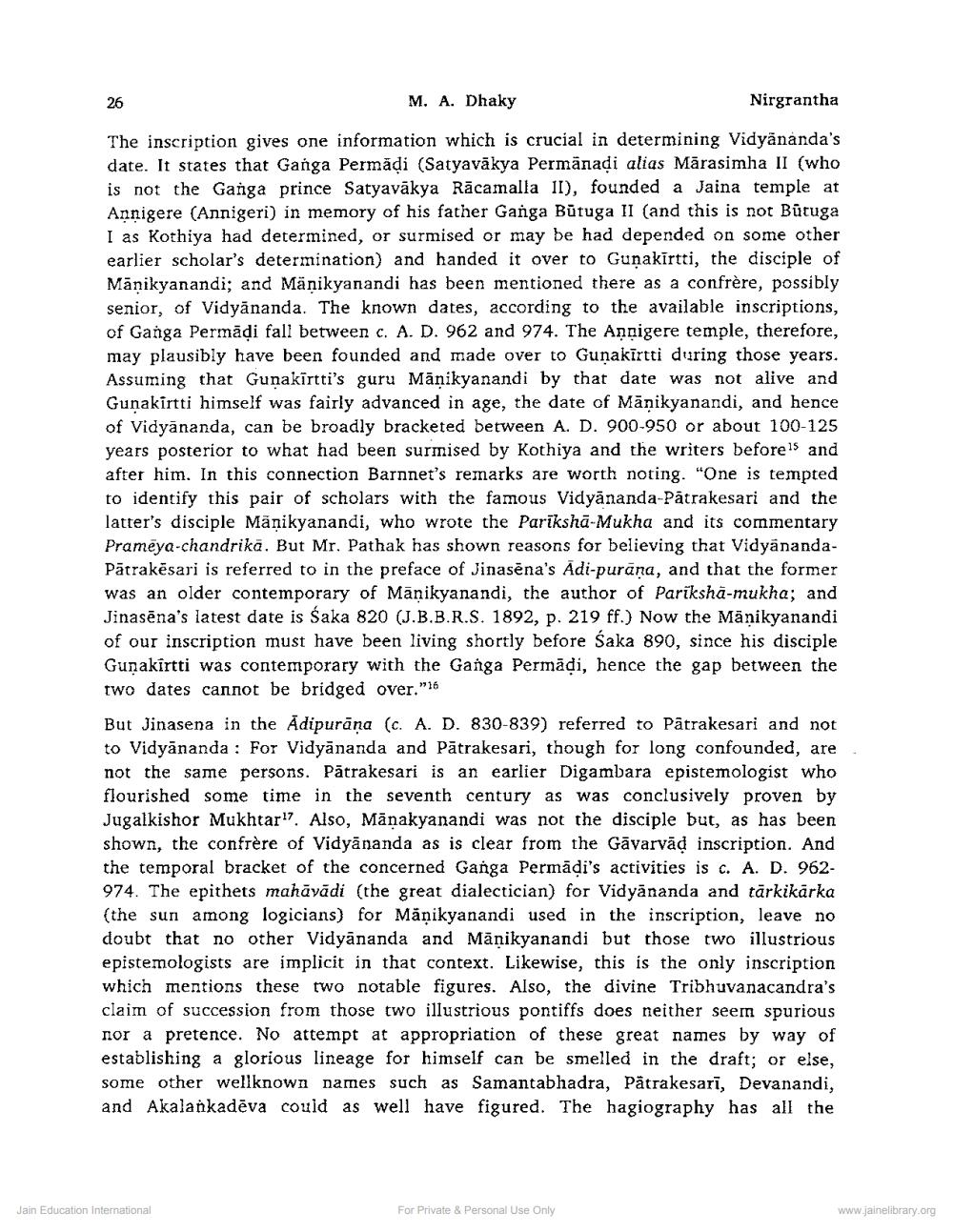Book Title: Date of Vidyananda Literary and Epigraphical Evidence Author(s): M A Dhaky Publisher: Z_Nirgrantha_1_022701.pdf and Nirgrantha_2_022702.pdf and Nirgrantha_3_022703.pdf View full book textPage 2
________________ M. A. Dhaky Nirgrantha The inscription gives one information which is crucial in determining Vidyānanda's date. It states that Ganga Permadi (Satyavākya Permānadi alias Mārasimha II (who is not the Ganga prince Satyavākya Rācamalla II), founded a Jaina temple at Annigere (Annigeri) in memory of his father Ganga Būtuga II (and this is not Būtuga I as Kothiya had determined, or surmised or may be had depended on some other earlier scholar's determination) and handed it over to Guņakirtti, the disciple of Mānikyanandi; and Mänikyanandi has been mentioned there as a confrère, possibly senior, of Vidyānanda. The known dates, according to the available inscriptions, of Ganga Permādi fall between c. A. D. 962 and 974. The Annigere temple, therefore, may plausibly have been founded and made over to Gunakīrtti during those years. Assuming that Gunakīrtti's guru Mānikyanandi by that date was not alive and Gunakirtti himself was fairly advanced in age, the date of Manikyanandi, and hence of Vidyānanda, can be broadly bracketed between A. D. 900-950 or about 100-125 years posterior to what had been surmised by Kothiya and the writers beforels and after him. In this connection Barnnet's remarks are worth noting. "One is tempted to identify this pair of scholars with the famous Vidyānanda-Pátrakesari and the latter's disciple Mānikyanandi, who wrote the Parīkshā-Mukha and its commentary Prameya-chandrikā. But Mr. Pathak has shown reasons for believing that VidyānandaPātrakēsari is referred to in the preface of Jinasena's Adi-purana, and that the former was an older contemporary of Manikyanandi, the author of Pariksha-mukha; and Jinasēna's latest date is Saka 820 (J.B.B.R.S. 1892, p. 219 ff.) Now the Mānikyanandi of our inscription must have been living shortly before Saka 890, since his disciple Gunakirtti was contemporary with the Ganga Permāļi, hence the gap between the two dates cannot be bridged over." But Jinasena in the Adipurāna (c. A. D. 830-839) referred to Pátrakesari and not to Vidyānanda : For Vidyānanda and Pātrakesari, though for long confounded, are not the same persons. Pārrakesari is an earlier Digambara epistemologist who flourished some time in the seventh century as was conclusively proven by Jugalkishor Mukhtar". Also, Mānakyanandi was not the disciple but, as has been shown, the confrère of Vidyānanda as is clear from the Gāvarvād inscription. And the temporal bracket of the concerned Ganga Permādi's activities is c. A. D. 962974. The epithets mahāvādi (the great dialectician) for Vidyānanda and tārkikärka (the sun among logicians) for Manikyanandi used in the inscription, leave no doubt that no other Vidyānanda and Manikyanandi but those two illustrious epistemologists are implicit in that context. Likewise, this is the only inscription which mentions these two notable figures. Also, the divine Tribhuvanacandra's claim of succession from those two illustrious pontiffs does neither seem spurious ror a pretence. No attempt at appropriation of these great names by way of establishing a glorious lineage for himself can be smelled in the draft; or else, some other wellknown names such as Samantabhadra, Pätrakesarī, Devanandi, and Akalankadēva could as well have figured. The hagiography has all the Jain Education International For Private & Personal Use Only For Private & Personal Use Only www.jainelibrary.orgPage Navigation
1 2 3 4 5 6 7 8
